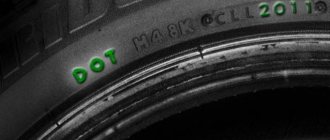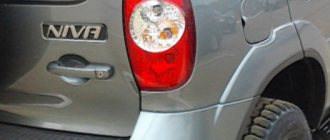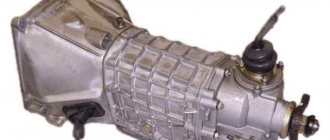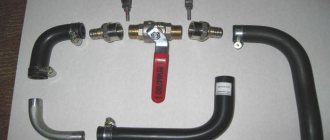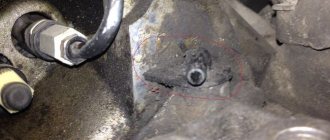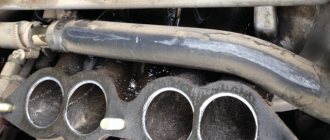Catalyst Removal 21214: Prerequisites
This element began to be used on VAZs relatively recently.
Unlike foreign cars, problems with catalysts on Niva (despite close cooperation with GM) arise much more often. The owners say that the resource of the standard element barely reaches 80 thousand kilometers.
It would seem that when a certain period is reached, it is enough to replace it with a new one.
But it's not that simple. The price of a new catalyst for a Chevrolet Niva is very high. And it is not always available.
Is it possible to remove it and save money?
As an alternative, numerous service stations offer removal of the catalyst and subsequent replacement. Instead it is possible:
- installation of a resonator from a UAZ or VAZ-2112;
- installation of a flame arrester (stronger), which is selected strictly according to the diameter and size of the pipe.
Along with this, the engine control unit is flashed. Otherwise, the motor will operate abnormally, intermittently.
How much does the catalyst removal procedure cost? For a Chevrolet Niva, the cost of removal is low, even with the installation of a blende. As the latter, an electronic emulator is used. It is possible to install a mechanical blende - it will be even cheaper.
Removing the catalyst: the correct procedure
The device cannot be repaired. The catalytic converter is a disposable honeycomb ceramic structure. The material is fragile, so it is difficult to remove it yourself. It is better to trust the professionals at the service station. Technicians with equipment will remove the damaged structure from the exhaust system.
Repair sequence:
- Removing the exhaust system.
- Removing ceramic elements from the muffler.
- Installation of flame arresters when removing the upper catalyst.
- Installation of a decoy for a lambda probe.
- Making corrections to the engine ECU.
The procedure for replacing the catalyst on a Chevy Niva must be accompanied by the installation of a lambda probe emulator. The trick is required to eliminate an error in the operation of the engine ECU. In the absence of a catalyst, the lambda probe will send incorrect data, which will lead to a richer fuel mixture.
Advantages and disadvantages of the procedure
Owners of the new Chevrolet Niva will be asked about the possible consequences of removing the catalytic system. After all, this is a direct interference with the operation of the car. However, the procedure also has its advantages, which were appreciated by owners of used Chevrolet Niva.
Advantages:
- Saving on car maintenance.
- Replacement will no longer be required.
- Factors that could disable the catalyst are reduced as negative. This applies to prolonged driving on a faulty engine, low-quality fuel, or impacts on the muffler while driving off-road.
- It is easier for the engine to release exhaust gases. Accordingly, the power will increase slightly.
The procedure for replacing a catalytic converter is similar to cutting out an appendix. They did it and forgot, that’s the principle. This procedure will not affect the driving performance of the car.
Flaws:
- The engine noise becomes more audible.
- The negative impact on the environment is increasing.
- The risk of getting caught during testing for compliance with CO2 emission standards increases significantly. Sometimes regulatory authorities do such checks, especially during special events.
- It will be difficult to pass the inspection.
- Additional costs for engine ECU exchange. It will continue to believe that the catalyst is present and working. The device readings will have to be corrected for the motor to operate correctly.
Owners must independently determine the risks of device removal procedures. Often you can’t do without it. The problem is the high cost of a new catalyst. Because of this, it is not practical to install a new device on an old car.
Removing a Chevrolet Niva catalyst: preliminary diagnostics
To accurately verify the malfunction, you will need computer diagnostics of the engine.
At the service station this procedure is performed as follows. The wizard connects to the OBD-2 connector and scans for errors using a laptop. On a Chevrolet Niva they will have the following code:
All these errors indicate “ineffective operation of the neutralization system and the lambda probe heater.”
After diagnosis, the specialist makes a decision. This could be replacing the lambda probe (this also happens with a working catalyst, at a mileage of up to 40 thousand), or completely removing the catalytic filter.
If we consider indirect symptoms, it could be:
- toxic odor of exhaust gases;
- metallic rattling and ringing in the muffler.
In the latter case, the ceramic part of the catalyst may peel off. It cannot freely leave the system and causes a characteristic rumble.
Consequences of a clogged catalyst
What is the danger of driving with a clogged element?
First of all, such a catalyst prevents the normal removal of exhaust gases. Some of them will penetrate back into the combustion chamber.
The pressure in the system increases significantly. There is a risk of burnout of the exhaust valves and depressurization of the pipes themselves. The engine will try to free the chamber from gases - the load on the piston group increases, and oil consumption increases.
To avoid problems with repairs, you should remove the catalyst as soon as possible.
Removing the catalyst on Niva 21214: consequences
Once removed, you will notice a significant increase in power. But let us immediately note that it will be within the factory values. After all, before this, the engine simply suffocated on its own gases and the power could drop by almost half. Gases will freely leave the combustion chamber - the risk of valve burnout is minimal.
Fuel consumption after removing the catalyst is within the factory values. But malfunctions will occur very rarely. After all, “when cold” the ECU is guided by average lambda values. And so on until the catalyst warms up. After removing it and flashing it, the unit will think that the neutralizer is already warmed up and will immediately begin to prepare the correct mixture.
The car will become less demanding on the quality of the fuel used. Even if there are deposits, all the dirt will fly straight into the pipe without being trapped in the filter honeycombs.
As for the negative aspects, after such “tuning” your environmental standards will immediately drop to Euro-2. But in Russia there are no penalties for this. It is completely legal to drive a Chevrolet Niva without a catalyst.
Chevy Niva: removing the catalyst in the workshop
Removing the catalyst is extremely simple and does not take more than two hours in a service station. In order for the technician to gain access to the catalyst, the car is placed on a lift. Next, unscrew the two fastenings of the catalyst - inlet and outlet. There are three bolted connections on each side. Unscrew with keys “13”. You need two spanners - with one the master holds the bolt, with the second he loosens the nut.
At the next stage, the specialist installs a straight pipe or a flame arrester in place of the standard fasteners. New gaskets are selected (two pieces - for the inlet and outlet), as well as six M8 bolts with nuts.
The second part of the work is setup. Through the diagnostic connector, the master installs new firmware on the electronic control unit. Values are set at which engine operation will be optimal in all modes. The unit will think that the catalyst is in order and prepare a mixture that achieves high power and fuel efficiency.
This completes the removal procedure. The service station provides a guarantee for its work.
Replacing the Catalyst on Niva 21214
But high-class auto repair shops have figured out how to deceive the engine ECU - we will reflash the engine ECU, excluding the second lambda probe from the circuit. The electronics “believes” that there is no second detector in the exhaust system, so it does not expect any readings from it, and the engine operates as usual. With the “bleeder” (installed after removing the catalyst), the consumption of the fuel mixture remains the same as before with the catalytic converter.
If the catalyst is excluded from the gas exhaust system on a gasoline engine, the combustion products of the fuel mixture will act as an unextinguished flame and lead to failure of parts of the gas exhaust system (resonator, muffler). To increase the service life of the gas exhaust system, it is necessary to install a flame arrester in it. If there is such a possibility, then you can replace the catalyst with a flame arrester in the same place. If the catalyst is simply thrown out of the system, the engine ECU will display the error “insufficient catalyst efficiency p0420”. To prevent this from happening, either a decoy is installed, or the engine ECU is fully re-flashed to operate within Euro2. The more modern and complex the car, the more complex the methods for testing and monitoring the efficiency of the catalyst, so the use of decoys in terms of the significance of the result comes to naught. For example, as catalyst performance decreases, the engine ECU can change the mixture composition to reduce catalyst wear.
When removing a particulate filter on a diesel engine, you must programmatically disable the use of the particulate filter in the engine ECU - make changes to the firmware. This allows you to further significantly improve the dynamic performance of the engine. The presence in the service station of specialists with the necessary qualifications, modern equipment, as well as firmware from global manufacturers of various car brands with the necessary modifications allow us to fully remove the particulate filter on almost any diesel engine.
Replacement and repair of catalyst, particulate filter
Do you need to remove the catalyst?
offers various options for solving a malfunction of the catalyst or particulate filter on your car. The most common of them are: replacement with a universal catalyst of EURO-3, EURO-4, EURO-5 standard imported, replacement of the catalyst with a flame arrester, installation of an oxygen sensor blende (minicatalyst), replacement of the particulate filter with a particulate trap, reprogramming the engine ECU to the Euro2 standard ( ECU firmware), additional services - disabling exhaust gas recirculation (EGR valve), disabling the intake manifold swirl flaps, disabling the AdBlue/SCR urea system. You can also order a catalyst, blende, minicatalyst, flame arrester in our store. We invite you to make an appointment with us at the service center nearest to you.
Installation of a universal catalyst
A huge number of catalytic converters of varying quality are produced for the aftermarket. There is an important point: such catalysts operate from 80 to 100 thousand km. As soon as a message appears on the dashboard of your car indicating that the catalyst is not working efficiently, then it is time to change the catalyst. What type of repair should you choose specifically for your car?
Even if you install an original catalyst, it will last much less than the stated time, since the car is not new and there are nuances both in the operation of the engine and in the operation of the fuel system. If you decide to install a universal catalyst, it will fail even earlier than the original one.
Our many years of experience show that on cars purchased on the secondary market, it is necessary to install catalysts with a higher loading of precious metals. This will help extend the life of the catalyst. There is another difficulty: creating a universal catalyst for each car model is almost impossible, because all cars have different engine sizes, power and exhaust system design.
That is why we use blocks with increased loading - homologated, that is, improved, with improved technical characteristics. Thus, you receive a high-quality replacement catalyst with a service guarantee of up to 5 years (about 100,000 km). Actual service life may be longer.
has many years of experience in repairing and installing catalysts on a wide variety of car models. We guarantee high quality work!
We recommend installing a universal catalyst if:
- Do you want to preserve the engine life set at the factory?
- You care about the environment and the future of your children
- Are you planning to travel by car outside the Russian Federation?
Removing the catalyst. Replacing the catalyst with a flame arrester
Unlike the catalyst, the flame arrester performs only the second function - it “focuses” the flow of exhaust gases, this is necessary for the normal functioning of the main resonator, but does not perform the “ecological” function of the catalyst - afterburning unburned fuel vapors to the required environmental standards.
In general, there are two options for replacing the catalyst with a flame arrester. The first is replacing the catalyst with a universal flame arrester. As a rule, this option is suitable for cars with an engine capacity of up to 2 liters, since the design of the universal flame arrester is quite sufficient for replacement. But for cars with an engine power of more than 2 liters, such flame arresters work quite loudly and are not very effective. The second option, suitable for more powerful machines and solving the problems listed above, is the manufacture and installation of an individual flame arrester. This flame arrester is made on the basis of the body of the original catalyst, with the necessary filling and noise insulation added for effective operation. The cost of installing a flame arrester depends on the car model and, of course, making an individual catalyst will cost more than a universal one, but if you are the owner of a fairly powerful car, then an individual flame arrester is the best solution!
After the procedure for replacing the catalyst with a flame arrester, it is necessary to install a mini-catalyst (oxygen sensor fake), or transfer the engine control program to the EURO-2 standard
The main disadvantages when replacing the catalyst with a flame arrester:
Modern cars are very demanding in terms of repair technology and do not allow the use of solutions that were used 5-10 years ago. For example, today, on many high-tech cars, removing the catalyst leads to irreversible consequences in engine operation, a significant reduction in engine life, loss of power by 20-25%, increased fuel consumption, and air pollution.
When it is permissible to replace the catalyst with a flame arrester:
If your car is older than 10 years, diagnostics of the catalyst showed its malfunction, and the cost of restoring the fuel system, ignition system, piston group is incommensurate with the cost of the car (the serviceability of these systems is a prerequisite for long-term operation of the catalyst) - installing a flame arrester will save you from these problems.
Removing the particulate filter. Installing a soot trap
If your car has indicated a malfunction of the DPF particulate filter, the EGR valve or the urea injection system, this indicates that the life of these elements has expired, which is characterized by a transfer to an “emergency” mode, a drop in power, an increase in fuel consumption, and in some cases, shutdown of the systems security.
There are two ways of repair - replacement with a new original spare part, which allows you not to deviate from the factory design of the car and not reduce the intended service life of the units, or removal of the particulate filter from the exhaust system, as well as software shutdown. The second solution is several times cheaper, but requires, first of all, a professional approach:
- 1. First of all, it is necessary to perform computer diagnostics of all systems. If faults are detected in systems other than the particulate filter, USR valve, or AdBlue urea injection system, it is necessary to restore the operation of these systems.
- 2. Using their own experience and the experience of leading automakers, specialists can offer the installation of a particulate eliminator instead of a particulate filter, which will partially fulfill the function of a particulate filter and maintain the necessary conditions for the operation of the turbine without losing its service life. Also, after mechanically removing the particulate filter, you should leave all the sensors in place and diagnose the wires and tubes of the control sensors.
- 3. The software shutdown stage is carried out provided that the particulate filter control sensors, USR valve, and AdBlue urea injection system are in good working order. In some cases, it is necessary to disconnect the exhaust pressure and temperature sensors from the connectors.
guarantees correct operation after replacing the particulate filter with a particulate trap and programmatically disabling the DPF particulate filter, EGR valve or AdBlue urea injection system, subject to the above conditions!
We replace and repair catalysts and particulate filters for the following car brands - Acura, Alfa Romeo, Audi, BMW, Cadillac, Chevrolet, Chrysler, Citroen, Daewoo, Dodge, Fiat, Ford, Honda, Hummer, Hyundai, Infiniti, Jaguar, Jeep , Kia, Land Rover, Lexus, Lincoln, Mazda, Mercedes, Mitsubishi, Nissan, Opel, Peugeot, Porsche, Renault. Saab. Seat, Skoda, Ssangyong, Subaru, Suzuki, Toyota, Volkswagen, Volvo


